An Assessment of Carbon Storage in China’s Arboreal Forests
Abstract
:1. Introduction
2. Study Area
3. Study Methods
3.1. Estimating Biomass
3.2. Estimation of Carbon Stores and Carbon Density
4. Results and Discussion
4.1. Analysis by Source and Age Group
4.2. Analysis by Tree Species (Group)
4.3. Analysis of Geographical Distribution Patterns
4.4. Discussion
5. Conclusions
Acknowledgments
Author Contributions
Conflicts of Interest
References
- Bellassen, V.; Viovy, N.; Luyssaert, S.; Maire, G.L.; Schelhaas, M.J.; Ciais, P. Reconstruction and attribution of the carbon sink of European forests between 1950 and 2000. Glob. Chang. Biol. 2011, 17, 3274–3292. [Google Scholar] [CrossRef]
- Fang, J.; Guo, Z.; Hu, H.; Kato, T.; Muraoka, H.; Son, Y. Forest biomass carbon sinks in East Asia with special reference to the relative contributions of forest expansion and forest growth. Glob. Chang. Biol. 2014, 20, 2019–2030. [Google Scholar] [CrossRef] [PubMed]
- Hayes, D.J.; Turner, D.P.; Stinson, G.; Mcguire, A.D.; Wei, Y.; West, T.; Heath, L.; Dejong, B.; Mcconkey, B.; Birdsey, R.A.; et al. Reconciling estimates of the contemporary North American carbon balance among terrestrial biosphere models, atmospheric inversions, and a new approach for estimating net ecosystem exchange from inventory-based data. Glob. Chang. Biol. 2012, 9, 1282–1299. [Google Scholar] [CrossRef]
- Saatchi, S.S.; Harris, N.L.; Brown, S.; Lefsky, M.; Mitchard, E.T.A.; Salas, W.; Zutta, B.R.; Buermann, W.; Lewis, S.L.; Hagen, S.; et al. Benchmark map of forest carbon stocks in tropical regions across three continents. Proc. Natl. Acad. Sci. USA 2011, 108, 9899–9904. [Google Scholar] [CrossRef] [PubMed]
- Lai, R. Carbon sequestration. Philos. Trans. R Soc. Lond. B Biol. Sci. 2008, 363, 815–830. [Google Scholar]
- Cusack, D.F.; Axsen, J.; Shwom, R.; Hartzell-Nichols, L.; White, S.; Mackey, K.R. An interdisciplinary assessment of climate engineering strategies. Front. Ecol. Environ. 2014, 12, 280–287. [Google Scholar] [CrossRef]
- Bonan, G.B. Forests and climate change: Forcings, feedbacks, and the climate benefits of forests. Science 2008, 320, 1444–1449. [Google Scholar] [CrossRef] [PubMed]
- Zhao, M.; Zhou, G. Carbon Storage of forest vegetation and its relationship with Climatic Factors. Sci. Geogr. Sin. 2004, 24, 50–54. [Google Scholar] [CrossRef]
- Valentini, R.; Mattenccl, G.; Dolman, A.J.; Schulze, E.D.; Rebmann, C.; Moors, E.J. Respiration as the main determinant of carbon balance in European forests. Nature 2000, 404, 861–865. [Google Scholar] [CrossRef] [PubMed]
- Schimel, D.; Melillo, J.; Tian, H.Q.; McGuire, A.D.; Kickleghter, D.; Kittel, T.; Rosenbloom, N.; Running, S.; Thornton, P.; Ojima, D.; et al. Contribution of increasing CO2 and climate to carbon storage by ecosystems in the United States. Science 2000, 287, 2004–2006. [Google Scholar] [CrossRef] [PubMed]
- Fang, J.; Chen, A.; Zhao, S.; Ci, L. Estimating Biomass carbon of China’s forest: Supplementary notes on report published in Science (291:2320–2322) by Fang et al. (2001). Acta Phytoecol. Sin. 2002, 26, 243–249. [Google Scholar]
- Liu, W.; Wang, X.; Lv, F.; Ouyang, Z. Regional and global estimates of carbon stocks and carbon sequestration capacity in forest ecosystems. Chin. J. Appl. Ecol. 2015, 26, 2881–2890. [Google Scholar]
- Fang, J.; Chen, A.; Peng, C.; Zhao, S.; Ci, L. Changes in forest biomass carbon storage in China between 1949 and 1998. Science 2001, 292, 2320–2322. [Google Scholar] [CrossRef] [PubMed]
- Sitch, S.; Smith, B.; Prentice, I.C.; Arneth, A.; Bondeau, A.; Cramer, W.; Kaplan, J.O.; Levis, S.; Lucht, W.; Sykes, M.T.; et al. Evaluation of ecosystem dynamics, plant geography terrestrial carbon cycling in the LPJ dynamic global vegetation model. Glob. Chang. Biol. 2003, 9, 161–185. [Google Scholar] [CrossRef]
- Gerten, D.; Schaphoff, S.; Haberlandt, U.; Lucht, W.; Sitch, S. Terrestrial vegetation and water balance—Hydrological of a dynamic global vegetation model. J. Hydrol. 2004, 286, 249–270. [Google Scholar] [CrossRef]
- Wang, B.; Liu, M.; Zhang, B. Dynamics of net production of Chinese forest vegetation based on forest inventory data. Forest Resour. Manag. 2009, 2, 35–42. [Google Scholar]
- Deng, L.; Shangguan, Z. Methods for forest carbon storage estimation based on forest Inventory Data. Bull. Soil Water Conserv. 2011, 31, 143–147. [Google Scholar]
- People’s Republic of China Ministry of Forestry. National Forest Resource Statistics (1984–1988); China Forestry Publishing House: Beijing, China, 1989.
- People’s Republic of China Ministry of Forestry. National Forest Resource Statistics (1989–1993); China Forestry Publishing House: Beijing, China, 1994.
- Jiang, Y.; Guo, Q.; Ma, J. Classification and Characteristics of Chinese Forest Communities; China Sciences Publishing and Media, Ltd. and China Forestry Publishing House: Beijing, China, 1998. [Google Scholar]
- Li, W.; Li, F. China Forest Resource Research; China Forestry Publishing House: Beijing, China, 1996. [Google Scholar]
- Luo, T. Biological Production Patterns in China’s Main Forest Types and Their Mathematical Models. Ph.D. Thesis, Chinese Academy of Sciences, Natural Resources Comprehensive Investigation Committee, Beijing, China, 1996. [Google Scholar]
- Ministry of Forestry. China Forestry Network. Announcing the Results of the 8th National Forest Resources Inventory. Available online: http://www.forestry.gov.cn/main/72/content-659780.html (accessed on 26 February 2014).
- Fang, J.; Chen, A. Dynamic forest biomass carbon pools in China and their significance. Acta Bot. Sin. 2001, 43, 967–973. [Google Scholar]
- Jiao, Y.; Hu, H. Carbon storage and its dynamics of forest vegetations in Heilongjiang Province. Chin. J. Appl. Ecol. 2005, 6, 2249–2252. [Google Scholar]
- Jia, S. Study on carbon storage of forest vegetation and its economic value in Henan Province based on continuous forest resources inventory. Hubei Agric. Sci. 2016, 55, 1612–1616. [Google Scholar]
- Ren, S. Statistical analysis of carbon storage of arbor stand in Shanxi. Shanxi For. 2011, 40, 35–37. [Google Scholar]
- Wang, M. Estimating Biomass and Carbon Storage of Arbor Stand in Shanghai. Master Thesis, East China Normal University, Shanghai, China, 2013. [Google Scholar]
- Wang, L.; Ding, J.; Ji, Y.; Liang, Z.; Li, R.; Ruan, H. The dynamic carbon storage and economic value assessment of forest in Jiangsu Province. J. Nanjing For. Univ. (Nat. Sci. Ed.) 2010, 34, 1–5. [Google Scholar]
- Zhang, M.; Wang, G.; Liu, A. Estimation of forest biomass and net primary production for Zhejiang Province based on continuous forest resources inventory. Sci. Silvae Sin. 2009, 45, 13–17. [Google Scholar]
- Li, L. Carbon Storage Dynamics in the Forest Vegetation of Yunnan Province from 1992 to 2007 and Analysis of Its Carbon Sink Potential. Master Thesis, Yunnan University of Finance and Economics, Kunming, China, 2012. [Google Scholar]
- Brown, S.L.; Schroeder, P.E. Spatial patterns of aboveground production and mortality of woody biomass for eastern U.S. forest. Ecol. Appl. 1999, 9, 968–980. [Google Scholar]
- Li, H.; Lei, Y. Estimates of Biomass and Carbon Stores in China’s Forests; China Forestry Publishing House: Beijing, China, 2010. [Google Scholar]
- Gao, Y. Carbon Density and Storage of Forest and Grassland Ecosystems in the Loess Plateau Region. Ph.D. Thesis, Northwest Agriculture and Forestry University, Yangling, China, 2014. [Google Scholar]
- Lamlom, S.H.; Savidge, R.A. A reassessment of carbon content in wood: Variation within and between 41 North American species. Biomass Bioenergy 2003, 25, 381–388. [Google Scholar] [CrossRef]
- Ma, X.; Wang, Z. Estimation of provincial forest carbon sink capacities in Chinese mainland. Chin. Sci. Bull. 2011, 56, 433–439. [Google Scholar] [CrossRef]
- Li, H.; Lei, Y.; Zeng, W. Forest carbon storage in China Estimated using forestry inventory data. Sci. Silvae Sin. 2011, 47, 7–12. [Google Scholar]
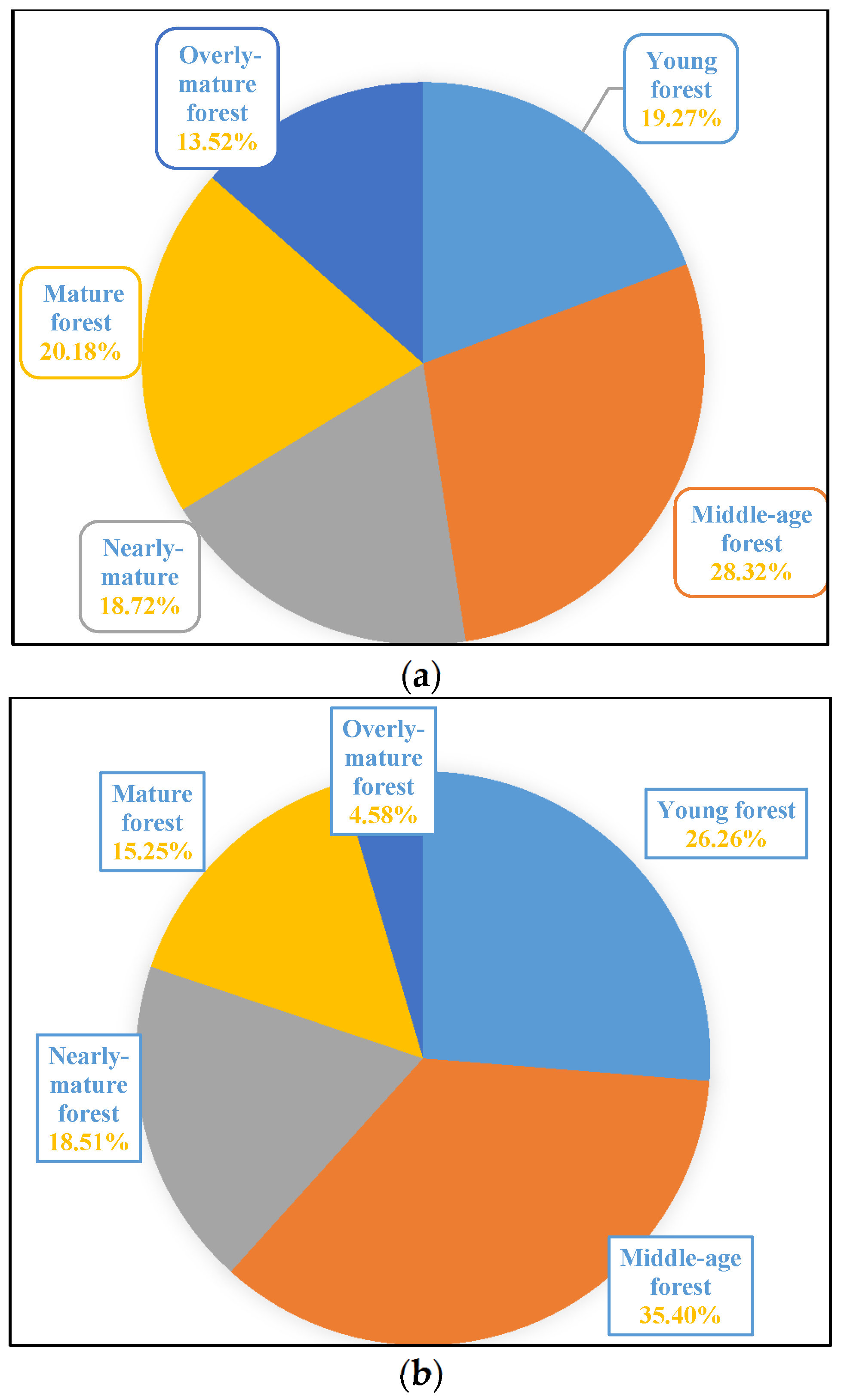
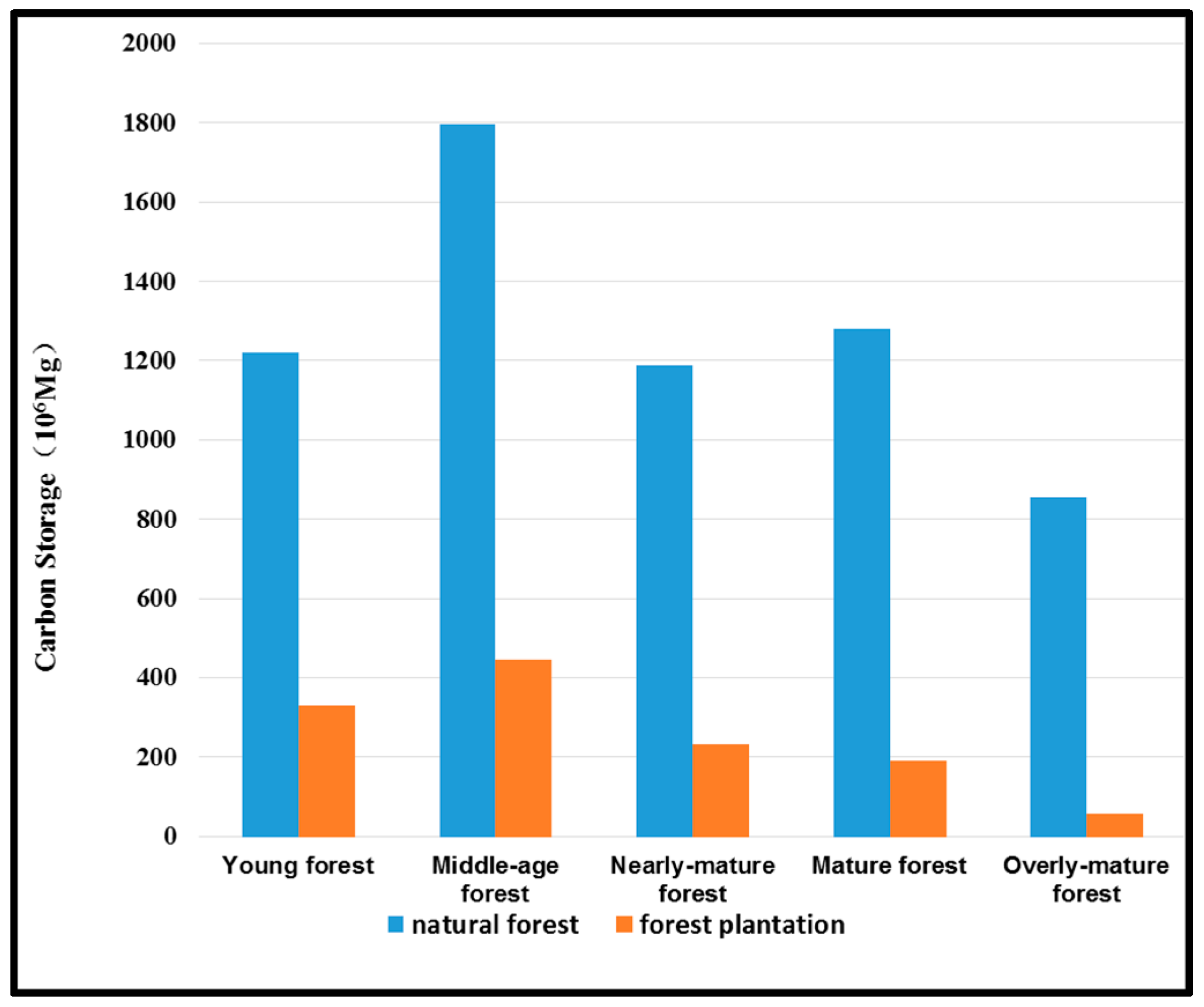
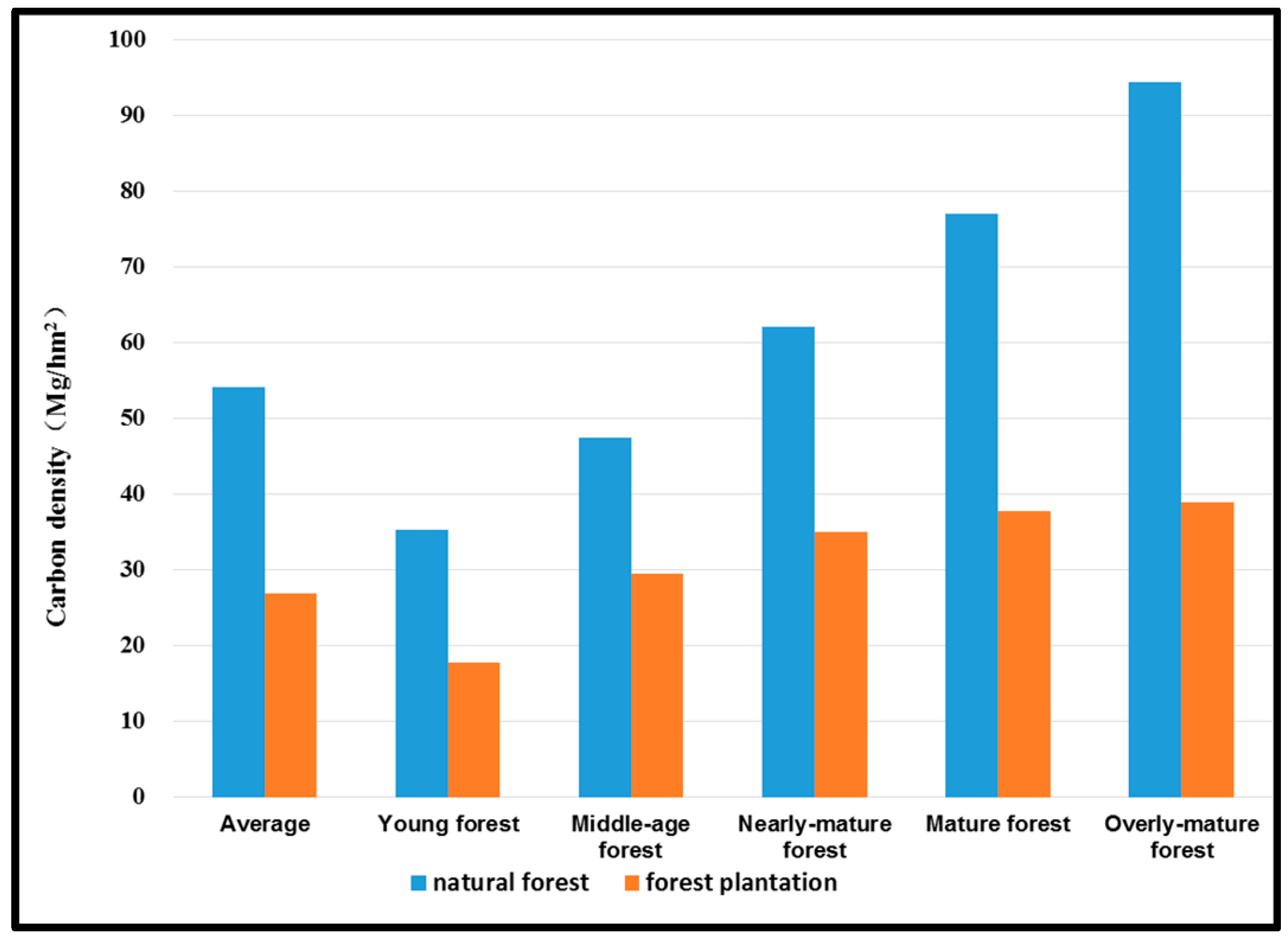
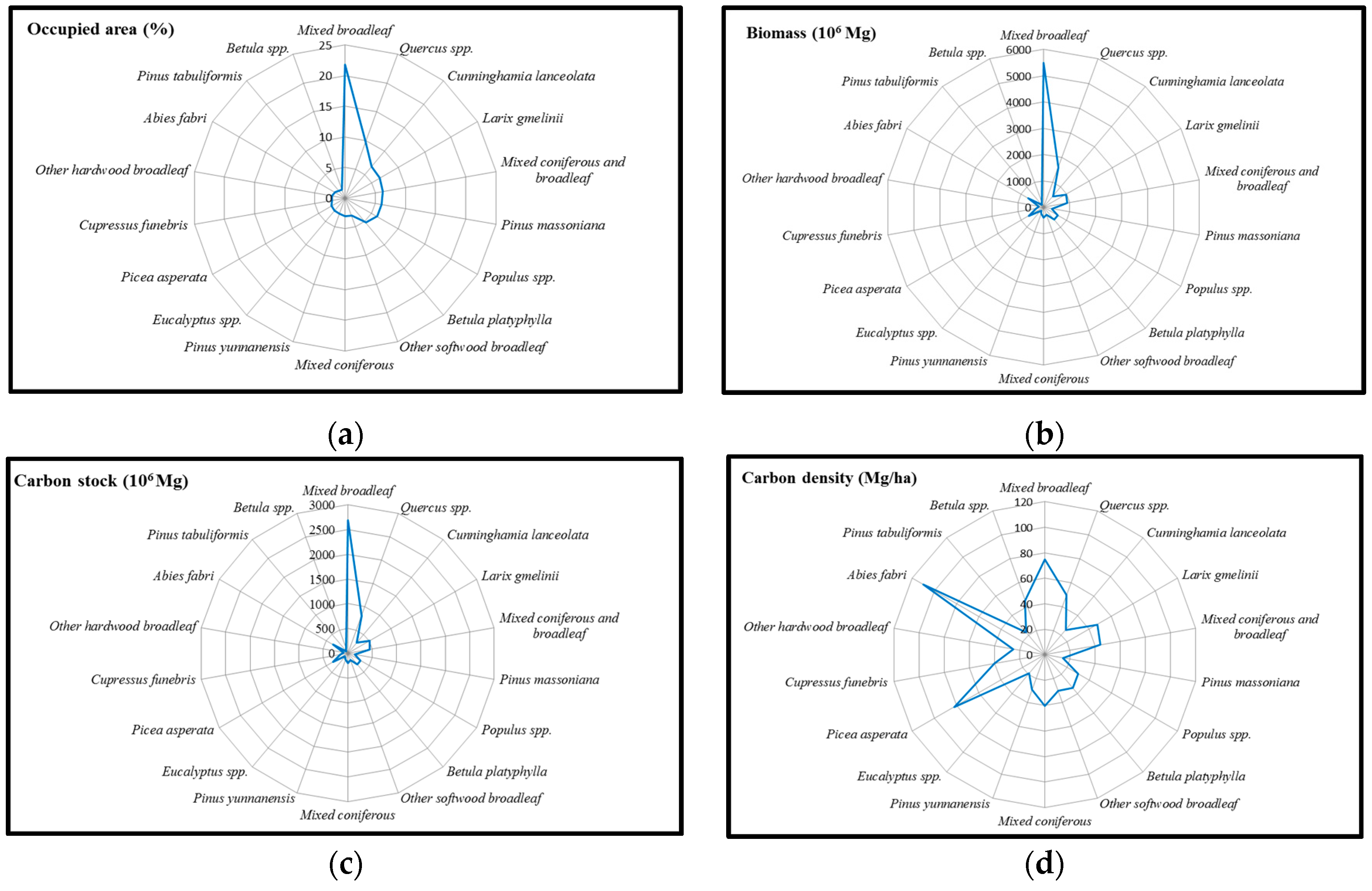
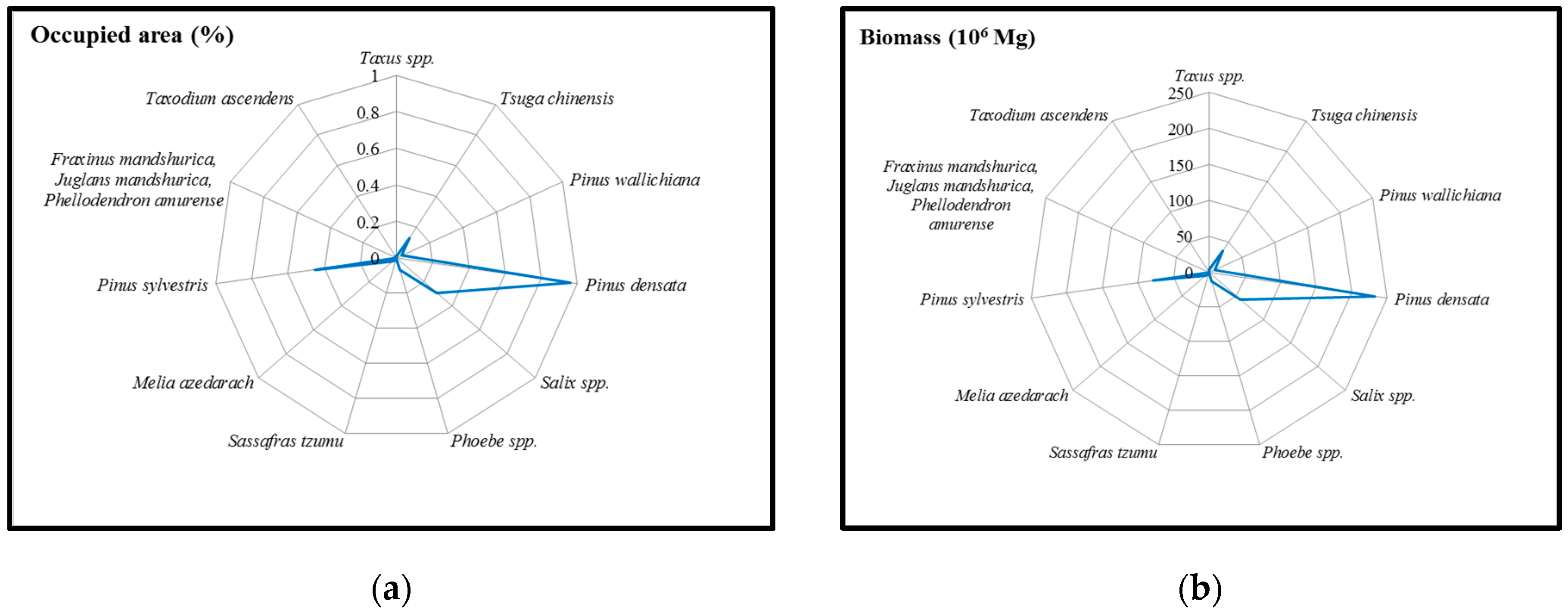
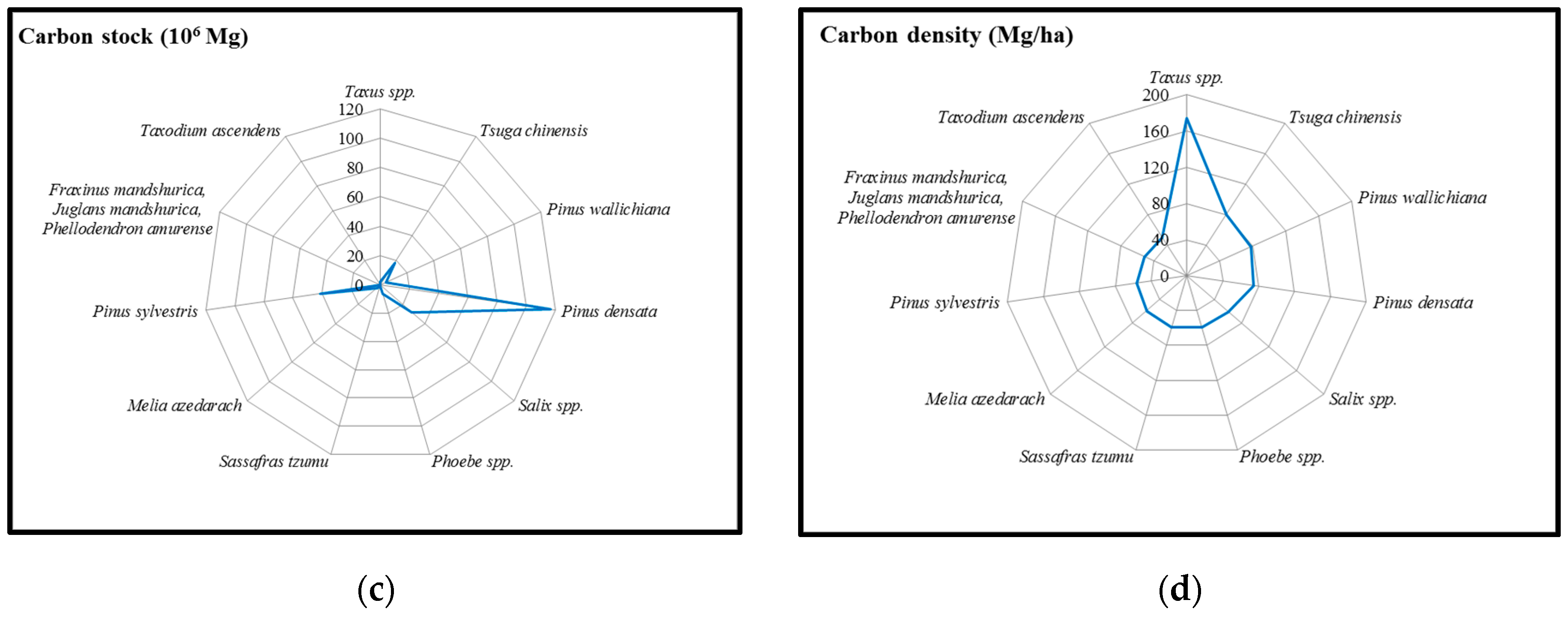

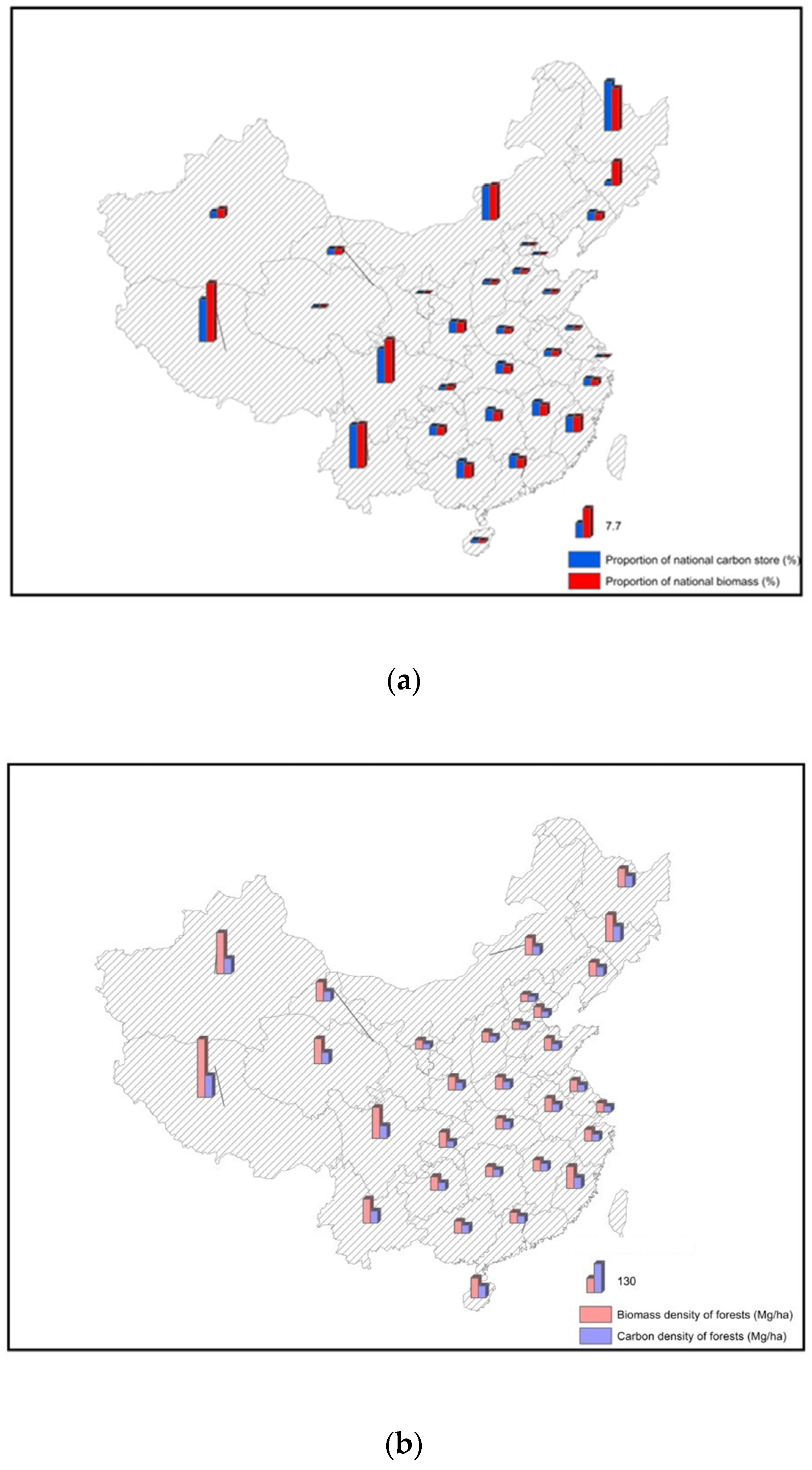

| No. | Tree Species | Biomass Expansion Formula Parameters | Cellulose Content (%) | Hemicellulose Content (%) | Lignin Content (%) | Carbon Factor | |
|---|---|---|---|---|---|---|---|
| a | |||||||
| 1 | Quercus spp. | 1.1453 | 8.5473 | 44.91 | 26.89 | 21.72 | 0.5004 |
| 2 | Pinus sylvestris | 1.0945 | 2.004 | 55.34 | 11.7 | 27.15 | 0.5223 |
| 3 | Pinus densiflora | 1.0945 | 2.004 | 50.19 | 21.62 | 23.45 | 0.5141 |
| 4 | Betula spp. | 1.0687 | 10.237 | 41.82 | 30.37 | 20.37 | 0.4914 |
| 5 | Phoebe spp. | 1.0357 | 8.0591 | 48.79 | 21.88 | 22.71 | 0.503 |
| 6 | Cinnamomum camphora | 1.0357 | 8.0591 | 47.46 | 23.41 | 21.2 | 0.4916 |
| 7 | Paulownia spp. | 0.8956 | 0.0048 | 44.30 | 21.32 | 21.37 | 0.4695 |
| 8 | Ulmus pumila | 0.8918 | 28.441 | - | - | - | - |
| 9 | Eucalyptus spp. | 0.8873 | 4.5539 | 40.33 | 20.65 | 30.68 | 0.5253 |
| 10 | Mixed coniferous and broadleaf | 0.8136 | 18.466 | - | - | - | 0.4978 |
| 11 | Fraxinus mandshurica, Juglans mandshurica, Phellodendron amurense | 0.798 | 0.42 | - | - | - | 0.4827 |
| 12 | Tilia spp. | 0.798 | 0.42 | 41.84 | 23.52 | 17.81 | 0.4392 |
| 13 | Robinia pseudoacacia and miscellaneous broadleaf hardwoods | 0.7564 | 8.3103 | - | - | - | 0.4834 |
| 14 | Pinus tabuliformis | 0.7554 | 5.0928 | 55.32 | 11.94 | 26.83 | 0.5207 |
| 15 | Casuarina equisetifolia | 0.7441 | 3.2377 | 42.55 | 17.94 | 27.66 | 0.498 |
| 16 | Mixed broadleaf | 0.6255 | 91.0013 | 0.49 | |||
| 17 | Sassafras tzumu | 0.6255 | 91.0013 | 42.91 | 22.08 | 23.57 | 0.4848 |
| 18 | Cupressus funebris | 0.6129 | 46.1451 | 50.13 | 7.72 | 29.87 | 0.5034 |
| 19 | Larix gmelinii | 0.6096 | 33.806 | 52.63 | 15.33 | 26.46 | 0.5211 |
| 20 | Pinus armandii | 0.5856 | 18.7435 | 56.17 | 19.63 | 22.34 | 0.5225 |
| 21 | Pinus koraiensis | 0.5185 | 18.22 | 53.98 | 13.48 | 25.56 | 0.5113 |
| 22 | Pinus thunbergii | 0.5168 | 33.2378 | 52.09 | 11.46 | 28.10 | 0.5146 |
| 23 | Mixed coniferous | 0.5168 | 33.2378 | - | - | - | 0.5101 |
| 24 | Metasequoia glyptostroboides | 0.5168 | 33.2378 | 42.19 | 9.05 | 32.92 | 0.5013 |
| 25 | Pinus densata | 0.5168 | 33.2378 | 47.26 | 13.99 | 27.65 | 0.5009 |
| 26 | Pinus hwangshanensis, Pinus taiwanensis, Pinus wallichiana, Pinus griffithii | 0.5168 | 33.2378 | - | - | - | 0.5 |
| 27 | Pinus yunnanensis | 0.5101 | 1.0451 | 49.89 | 11.42 | 28.91 | 0.5113 |
| 28 | Pinus massoniana | 0.5101 | 1.0451 | 43.45 | 10.09 | 26.84 | 0.4596 |
| 29 | Pinus kesiya | 0.5101 | 1.0451 | 50.91 | 25.74 | 22.18 | 0.224 |
| 30 | Populus spp., Acacia spp., broad-leaved softwood | 0.4754 | 30.6034 | 44.57 | 21.54 | 24.28 | 0.4956 |
| 31 | Picea asperata | 0.4642 | 47.499 | 58.96 | 8.14 | 26.98 | 0.5208 |
| 32 | Abies fabri | 0.4642 | 47.499 | 41.34 | 17.19 | 28.96 | 0.4999 |
| 33 | Cryptomeria japonica | 0.4158 | 41.3318 | 43.03 | 11.18 | 32.24 | 0.5235 |
| 34 | Tsuga chinensis | 0.4158 | 41.3318 | 44.96 | 9.79 | 31.13 | 0.5022 |
| 35 | Keteleeria fortunei | 0.4158 | 41.3318 | 55.13 | 7.7 | 26.73 | 0.4997 |
| 36 | Cunninghamia lanceolata | 0.3999 | 22.541 | 33.51 | 10.76 | 32.24 | 0.5201 |
© 2017 by the authors. Licensee MDPI, Basel, Switzerland. This article is an open access article distributed under the terms and conditions of the Creative Commons Attribution (CC BY) license (http://creativecommons.org/licenses/by/4.0/).
Share and Cite
Shao, W.; Cai, J.; Wu, H.; Liu, J.; Zhang, H.; Huang, H. An Assessment of Carbon Storage in China’s Arboreal Forests. Forests 2017, 8, 110. https://doi.org/10.3390/f8040110
Shao W, Cai J, Wu H, Liu J, Zhang H, Huang H. An Assessment of Carbon Storage in China’s Arboreal Forests. Forests. 2017; 8(4):110. https://doi.org/10.3390/f8040110
Chicago/Turabian StyleShao, Weiwei, Jingya Cai, Haibing Wu, Jiahong Liu, Haixing Zhang, and Hao Huang. 2017. "An Assessment of Carbon Storage in China’s Arboreal Forests" Forests 8, no. 4: 110. https://doi.org/10.3390/f8040110






